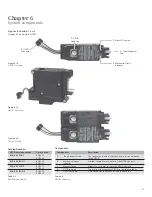
11
Chapter 4
Inspection and testing
Overview
Before the equipment is energized, it
must be thoroughly inspected and tested.
Any deviation must be corrected prior
to energizing.
Inspection
Check the following points:
1. All mechanical connections are tight,
as factory connections may loosen
during shipment and storage.
2. All accessible electrical connections are
tightened to the torque specifications
on the panel labeling.
3. All bolt-on screws connecting breakers
and phase bus bar are properly
installed and tightened.
4. Connections between SIPODs and
BQD breakers are properly secured
and
torqued.
5. Connections between SIPOD connectors
and Data Rails are secure and properly
oriented.
6. Both ribbon cable connections
between Data Rails and i-3 V2
Controller I/O Board are properly
orientated.
7. All blocking supports and packing
materials have been removed from all
component devices and lighting panel.
8. All ground connections are properly
made (Note: ground wire to be
installed after the panel box is
mounted on the wall).
4. After all upstream devices have been
turned ON, loads such as lighting
circuits may be turned ON to verify
that the system operates as intended.
System diagnostic test
For Controllers without touch screen
(I/O Controller) - A computer with the i-3
V2 software Configurator Tool is required
to be connected to perform the system
diagnostic test. Refer to the “i-3 V2 I/O
Controller User Guide” for more
information on using the Configurator
Tool program.
System controllers with touch screen
Once energized, the controller will prompt
the user for basic setup information. If
SIPODs that are installed show as NA on
the controller screen, then de-energize the
panel, remove the deadfront and check all
connections. Once all SIPOD modules are
connected and operating properly, refer
to the “i-3 V2 System Controller User
Guide” for further instruction on set up
and commissioning.
9. In accordance with Section 725.136
of the NEC® field-installed Class 2,
Class
3,
and other low voltage
conductors shall be separated by a
minimum 1/4 inch from factory- or
field-installed light, power, Class 1,
non-power-limited fire alarm circuit
conductors, and medium power
network-powered
broadband
communications cables. Separation
of conductors may be accomplished
by clamping, routing, or an
equivalent
means.
10. All foreign materials have been
removed from the panel and enclosure
before installing the deadfront
and
trim.
11. Before energizing – Deadfront
is properly aligned and securely
installed.
12. Before energizing – Trim is properly
mounted and securely installed.
Testing
Perform the following tests prior to
energizing the panel:
1. Exercise all breakers.
2. SIPODs can be manually closed
to allow circuit testing prior to
commissioning of the controller.
Energizing
1. Panelboard deadfront and trim must
be installed before energizing.
2. To minimize the risk of injury or
damage, there should be no load on
the P1 panel when it is energized.
3. The equipment should be energized in
sequence, starting at the source end
and working towards the load end.
In other words, energize the main
devices, then the feeder devices,
and then the branch circuit devices.
DANGER
Hazardous voltage.
Will cause death or
serious injury.
Keep out.
Qualifi ed personnel only.
Disconnect and lock off all
power before working on
this equipment.
Содержание i-3
Страница 1: ...3 Installation Guide www usa siemens com i 3 i 3 Control Technology V2 ...
Страница 35: ......














































